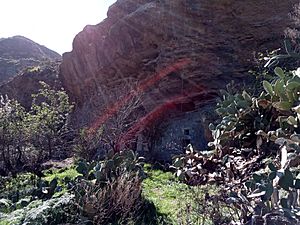Risco Caído facts for kids
| UNESCO World Heritage Site | |
|---|---|
 |
|
| Location | Gran Canaria, Canary Islands, Spain |
| Criteria | (iii)(v) |
| Inscription | 2019 (43rd Session) |
| Area | 9,425 ha |
| Buffer zone | 8,557 ha |
Risco Caído is a very special place on the island of Gran Canaria in Spain. It is an important archaeological site with ancient cave homes, temples, and places where people stored food. These were made by the first people who lived on the Canary Islands long ago. Some people also think Risco Caído was used as an observatory to watch the stars.
In July 2019, Risco Caído was named a UNESCO World Heritage Site. This means it is a very important cultural and natural place for everyone in the world. It is the first World Heritage Site on Gran Canaria and the fourth in the Canary Islands.
Exploring Risco Caído
Risco Caído is in the middle of Gran Canaria. It is a big island with mountains, deep valleys, and volcanoes. This area is also home to many different plants and animals.
The landscape includes many troglodyte (cave-dwelling) homes. There are also places where people stored grain and collected water. These ancient structures show that a unique culture lived on the island. This culture developed on its own from around the time of Christ. It continued until the first Spanish settlers arrived in the 1400s.
The cave complex also has special places for worship. These include two sacred temples called almogarenes: Risco Caído and Roque Bentayga. People held seasonal ceremonies here. It is thought that these temples were used to worship the stars and Mother Earth.
Different Ideas About Risco Caído
Some experts have different ideas about Risco Caído. For example, a mathematician named José Barrios has questioned if it was truly an ancient astronomical observatory. He believes there is not enough scientific proof for this idea. He also thinks other important archaeological sites on Gran Canaria, like the Four Doors site, should get more attention.
Another geographer, Eustaquio Villalba, also doubts the observatory idea. Both critics point out that much of the information comes from one article. This article was written by Julio Cuenca, who discovered the site. They believe more scientific studies are needed to fully support the claims.
According to Barrios, there are no clear signs or markers that prove it was an astronomical observatory. He says there are no published scientific reports that fully support this theory.
See also

